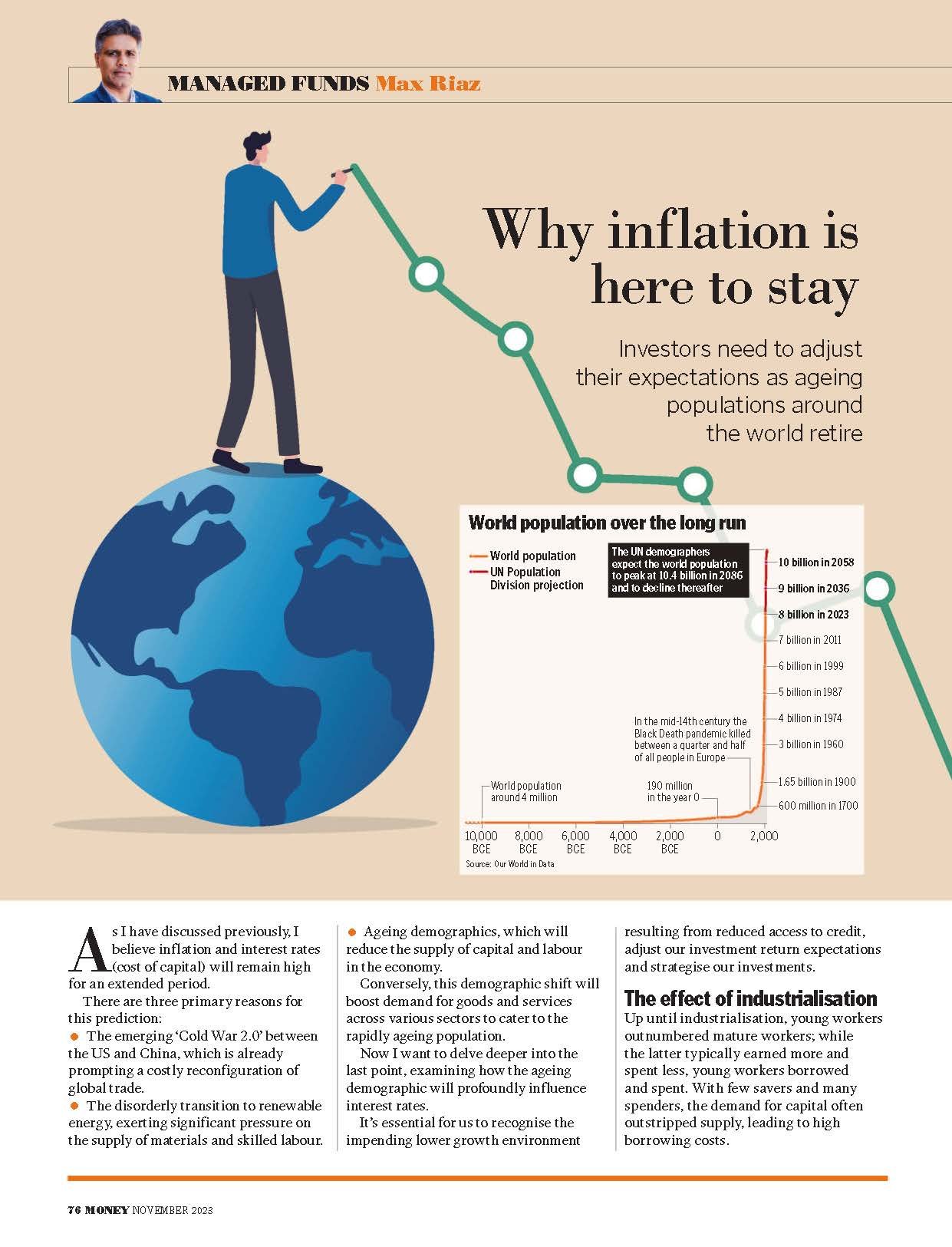CHINA FOCUS: COMMONLY HELD MISCONCEPTIONS ABOUT THE CHINESE ECONOMY
/The narrative we read and see being perpetuated about China in the media paints a country that must be feared and sceptical of. In this article, we explore some of the negative perceptions and present a counter-narrative in the hope to bring some balance to the argument. It wasn’t too long ago that perception of China was quite positive in the West but over the past five to six years the perception has become starkly negative. The reasons for this change are related to economics and trade between China and the West. At Banyantree, we are ultimately interested in assessing the prospects of ongoing economic growth in China and how our clients can be positioned for future opportunities that are tied to the Chinese economy.
#MISCONCEPTION 1: THAT AMERICAN COMPANIES HAVE LARGE FDI’S IN CHINA AND SO EXPORTING AMERICAN JOBS TO CHINA
A commonly held belief in America over the years has been that China is getting too much investment from US firms in manufacturing and other sectors and stealing jobs from America. However, the facts tell a different story. When we look into America’s foreign investment to China we find that it is a measly 1.8% of total foreign US investments. In absolute numbers, it is $108 billion of the total $5.5trillion that the US has invested globally. Compare this to countries like Japan and Taiwan who have around a quarter of their total foreign investment going into China. The US has invested more in Australia than in China! Thus conventional wisdom is way off the mark in its belief that US foreign direct investment in China is large.
#MISCONCEPTION 2: CHINA IS THE CAUSE OF UNITED STATES’ TRADE DEFICIT
Let’s take a look at the bilateral trade deficit that the US runs with China. It currently sits at $418b and accounts for 50% of the United States’ total trade deficit with the world. The average American believes that if they just cut the trade deficit with China that will reign in their total deficit by a big chunk and help grow jobs locally in the US. It can be argued that America has intentionally run trade deficits to support the US dollar as the reserve currency for the world’s trade.
In other words, the US has championed imports as a mechanism to circulate more and more US dollars around the world so it maintains its reserve currency status. For that reason, America has been ramping up trade deficits ever since it revoked the Bretton Woods System in 1971 and unpegged the US$ to the gold reserve. Previously, the Bretton Woods system required a fixed conversion of US$1 to 35 ounces of gold and made USD the reserve currency of the world. Countries trading in the US dollar could exchange their US$ reserves into gold at any time at the above exchange rate. However, leading to 1971 after world war two, the US aggregate demand for goods from other countries was strong and it paid for these imports in US$. Exporting countries demanded to exchange their increasing US$ reserves for gold. This put pressure on the supply of gold and raised concerns of not having enough gold to meet the demand for conversion, so in 1971 U.S. president Nixon effectively ended the dollar convertibility to gold and ushered in a new era where the U.S. dollar became the global currency. And U.S. government bond securities became the most demanded foreign reserve in the world. Together the US dollar and US government bond securities became the international medium of exchange and store of value. Effectively, the US gave itself total control over printing the US dollars and issuing as much US debt as it needed to fund its consumption. And the countries it imported from accepted US dollars as payment for their goods. This became the source, and not China, for running up trade deficits.
We can see that China was running a balanced trade account until around 2004/5 while the US had already chalked up over $400b in annual trade deficits by that time. So China is not the cause of the US’ trade deficits. Moreover, we can see that since 1970 America’s trade deficit has gone from non-existent to close to $621b in 2018.
Take the example of Apple Inc, a US company that manufactures all of its products in China including its 250 million iPhones made entirely in China. How much do you think China receives in value for producing a US$650 iPhone? The answer is $25! So not a lot. Another $250 goes towards parts and components that come from other Asian countries such as Taiwan, Korea, and Japan. And the balance $200-$300 come back to Apple as profit. Now, given that Apple produces all of its products in China, one would think that Apple must have a large investment in manufacturing and assembly in China. The reality is that Apple’s investment in China is zero! All the investment in producing Apple products in China comes from a Taiwanese company. Apple has no foreign investment in China, which again flies in the face of conventional wisdom that US companies invest in China.
# MISCONCEPTION 3: CHINA ECONOMY IS RELIANT ON ITS CHEAP LABOR FORCE
The Chinese government has laid out artificial intelligence, including robotics and automation, as key areas it wants to grow in. One must ask the question why is China focused on automation and robotics when it has millions and millions of ready workforce that needs to be put to work? The talk of automation and robotics instils fear of job losses in the developed world, so why is China championing it as a formal government policy?
Well, China is the world’s first country that is going grey and rich simultaneously. And so, the labour force in China in absolute numbers has been shrinking in the past seven years. China’s workforce, those aged between 16 and 59, was 897.3 million in 2018, a 4.7 million drop from 2017. The workforce is on track to decline by as much as 23 percent by 2050. With such projected declines in working population China has no choice but to become more innovative and focus on automation.
The number of people employed in manufacturing has been declining over the past decade anyway, so the focus going forward is not about job creation in Chinese manufacturing, it is about smarter, value-added manufacturing with full automation. In contrast, the number of jobs in the US manufacturing sector has been increasing over the past few years.
With rising incomes, the Chinese economy is beginning to make the transition to a services economy. The services sector is starting to take off and manufacturing is starting to shrink and will continue to decline, not unlike what we have seen in most developed economies where the manufacturing sector has treaded a long term decline. Whatever manufacturing there will be in China it will be highly value added, and heavily automated as China will continue to have a shrinking labour force. Competition for labour will also rise from the services sector as it typically is more labour intensive, driving up income levels.
# MISCONCEPTION 4: CHINA IS VERY CORRUPT AND IT IMPACTS BUSINESS AND GROWTH
Let’s explore a couple of points here before we discuss corruption in the context of China. The conventional wisdom suggests that the more a country is corrupt, the less economic growth it is likely to experience because such countries get lesser foreign investment. A lot of emerging market economies can fall into this category e.g. India, Latin America etc. The second conventional wisdom says that the richer a country becomes the less corrupt it is likely to be, for example, European countries and America fall into this category.
The contention then is that these two conventions don’t hold for China. Corruption has allowed China to grow more rapidly than normal and the richer it gets the more corrupt it becomes (Xi Jinping has been busy driving his anti-corruption campaign). So why is China not following the general conventions of corruption? The difference between China and say India is that China is a mixed economy where the State controls the ownership of all key resources but the private sector is allowed to generate higher returns if it could use these resources effectively.
Deng Xiaoping, in the 1980s, couldn’t just freely go about privatising state’s resources, that would have gone against the socialist State’s ideology. But Deng Xiaoping realised that he needed to get these resources into the hands of private entrepreneurs (knowing that politically he couldn’t privatise these assets) so corruption became the means by which he transferred the States resources into private sector’s control. He got the backing of his party and officials as they were able to share in this policy and its benefits. So the faster the country grew the more benefits were shared around the party functionaries. This was the root of the Communist party’s managed corruption that ignited economic growth in China.
Compare this corruption to India where resources are already owned by the private sector and whenever a private sector participant wants to do something it needs the permission of a government official and the government official sees that as an opportunity to derive bribes by holding back the decision. The more the official holds back the more he gets bribed. So corruption impedes growth in India’s case (or in the vast majority of cases around the world). In China, though, the official is motivated to share in the transfer of the state’s resources and to encourage greater production, this is truly unique in the case of China.
But such institutionalised corruption is leading to extreme inequalities in China. This is unsustainable and unacceptable and can cause civil unrests, that is why we are seeing Xi Jinping clamp down on corruption in China. But there is a problem, if this corruption has been the source of economic growth for China, what will happen if this corruption is stamped out? What will be its substitute?
Economic liberalisation is an area of challenge for China to grapple with in the coming years. But it is important to remember that China is a country that has grown 10% p.a. over the past thirty years in spite of a weaker rule of law, relatively weaker institutions, and limited accountability. Another key difference in China’s development model to that of India, Indonesia, or others is that it is a very competitive economy when trading with external markets and very competitive internally with its provinces competing with each other. The head of a province doesn’t come from the province, he is appointed from Beijing with the mandate that he needs to develop and improve the conditions of the province. He competes with leaders of other provinces. His success then determines his promotion within the party. Xi Jinping has worked through four or five major leadership positions in different parts of China and now he is president. All provinces operate in businesses, make investments, and have private firms competing within the local economy, whereas, in other developed countries like India, states and provinces don’t compete with each other. Thus it is a very different economic model than what we see in the West, it has worked well for China for a generation.
# MISCONCEPTION 5: SOCIAL UNREST IS AN EXISTENTIAL THREAT TO THE COMMUNIST PARTY
China keeps a close track of social unrests around the country, these can range from group-based protest activities to disconcert at an individual level. The cost of internal security maintenance has been growing rapidly and it is more than the cost of running China’s military. But don’t be quick to judge if that means there is a real threat to the communist party.
The protests we have seen around the globe e.g. Arab spring are not the same as those in China in terms of their political implications for the central government. In fact, to date, by and large, the protests in China have strengthened the communist party’s image. The protests in China tend to be against the local officials who are accused of corruption or being unfair and if the situation becomes desperate and reaches the central government for resolution, they are then usually seen as saviours of the country. Protests have strengthened the centre and are a signal for the centre to see where the issues are so they can address them.
# MISCONCEPTION 6: CHINA’S DEBT IS TOO HIGH
There is much commentary around China’s debt being unsustainable and potential implications for its economy. The belief that China has a debt problem stems from China’s debt to GDP ratio of around 260%. This debt includes household, government, and corporate. The ratio has risen significantly from 50% in the early 1980s to its current levels. But this is not such a bad thing and certainly not out of the ordinary. It is a consequence of a country that has been knocking up strong economic growth over the same period, to now being World’s number two economy.
China’s total debt to GDP ratio is much lower than the US’ debt ratio of over 300%. China’s debt ratio also ranks in the middle of the range of debt ratios of other developed economies. The other argument that analysts mount about China’s debt is that it rose quickly over the past 10 years and whenever that has happened in an economy, such economies have collapsed every time. The counter to this analysis, as proposed by the economist Yukon Huang, is that this inference does not apply to China. People don’t understand the role land prices have played in China and their backing of the debt position. China’s property prices have increased 600% over the past decade driven by an increase in land prices. Equally, the price of land under shopping malls and land used by infrastructure have gone up significantly in valuation. The issue then arises that is this increase in prices sustainable? could there be a significant reversion of house/land prices?
What needs to be remembered about China’s property market is that there was no private property in China 15 years ago. The surge in prices has gone from impractically low levels to levels that you would expect for Asia and densely populated but high growth cities such as Beijing. A simple glance at Beijing’s price rise over the past two decades appears concerning. But if compared to another major metropolis in Asia such as Mumbai in India then Beijing is on par with such other Asian cities.
The price to income ratio of property in Beijing is 46x while in Mumbai it is 44x and India’s economic growth rate has been at half the rate of China’s growth yet no one is talking about a property crash in Mumbai. China’s debt surge is largely due to a surge in land prices which have been catching up after being privatised. In China, while there is a lot of private wealth in property there is an equally impressive amount of wealth in e-commerce and internet assets. Also, it needs to be remembered that 95% of Chinese own their own homes, and that is because in the late 1990s the State gave the rights to homes in rural areas while in urban areas you could buy property from the State for a fairly nominal amount. So a very interesting situation emerged in China, a very large number of people have built up equity through home ownership while land prices have been rising steeply.
THE END.





































